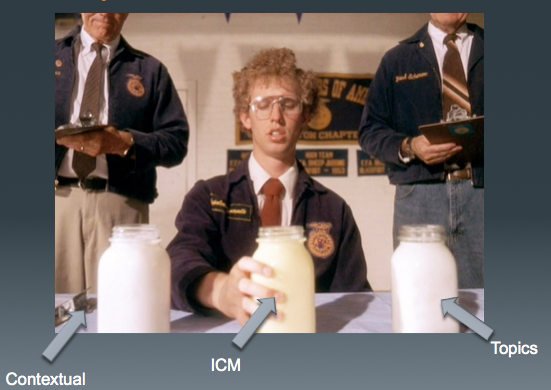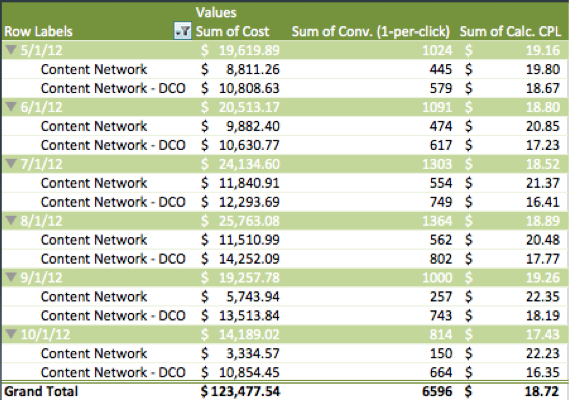For this Month’s Series, we’re going to be talking about new and exciting things that you can test within the wonderful world of PPC. Take your accounts to the next level with some of these new techniques or tools.
I get it; it’s terrifying. Our accounts are our babies. We dote on them, check them obsessively, think about them when we wake up in the morning. We like to be in control of everything in them. And then Google comes along with a feature (the Display Campaign Optimizer) that basically says to us “we’ll take it from here.”
I get the hesitation, but this year you should make a resolution to give the Display Campaign Optimizer a chance. I’ve seen tremendous results in my accounts with it. It is absolutely worth the effort.
We’ve written about the DCO in these parts before, but that was over two years ago. A lot has changed and evolved over those two years (it was even referred to as the “Display Conversion Optimizer” back then), so I wanted to provide an update.
If you’re eligible to use the DCO, you’ve probably noticed already. If you have a display campaign with over 15 conversions/month you’ll start seeing this warning.
This campaign type has tremendous spending potential, so Google advertises it pretty aggressively (along with a lot of their various “helpful tips” that lead to more money for them). It’s almost like that babysitter that you aren’t ready to hire was posting flyers on your fridge and bathroom mirror.
By clicking “View” on that warning you can see which specific campaigns are qualified for the new campaign type. Should you decide to take the plunge, you’ll want to pick the campaign with the most conversions out of the bunch. The more history Google has to go on, generally the better your campaign will be.
Just like a cow that got into an onion patch will produce milk with a slightly more onion-y flavor, the targeting method of the campaign that you’re copying over will influence what your DCO campaign ends up being (at least at the start). The DCO will know what worked in the past and start from there. Eventually it becomes its own thing, but at the start expect its targeting to align with the type of campaign it used to be.
There are some general steps you need to follow in the interface to set your campaign up, and I also have some tips that have worked in my accounts that will hopefully aid you in your quest for maximum conversions.
The DCO requires you to transition existing standard-targeted campaigns with enough history/conversions over to the auto-optimized option. On your settings tab, under advanced settings, there is a set of choices under automatic campaign optimization that you can change from Standard to Auto-Optimized for whichever campaign you choose to transition over to the new style. Click that button and you’re in.
Making that one change is simple enough, but before you do that I have some other recommendations for you.
First, you want to copy whatever campaign you are transitioning over and create a new version. Down the hypothetical road, when your DCO campaign is a wild success, you’ll want to be able to track your campaigns separately. If you choose to leave your regular targeting in place while being auto-optimized, you would be able to see what the DCO is doing by subtracting out all of the other targeting methods on the Display network tab. It’s an extra step that will slow you down eventually, so I recommend creating a brand new campaign to house your traditional targeting.
During the transitional phase, you don’t want to risk losing all of those conversions from your biggest display campaign, so here is the process I follow:
- In your auto-optimized DCO campaign, create new ad groups without any targeting in them at all.
- I generally like to create one ad group for text ads and then one ad group for each size of image ad that I’ll upload (my ad group names are 160×600, 200×200, etc). Ad sizes can perform wildly differently, so I find that the added control of grouping all sizes together can go a long way toward improved performance.
- Leave your pre-existing ad groups running alongside the new ones, although at a slightly lower CPA bid.
- You want to transition your traffic to your new, DCO-specific ad groups. By setting the old ad groups at a lower CPA, Google will have more incentive to divert traffic to the new ones.
- Meanwhile, in your newly copied campaign (that’s running standard targeting only), manually manage your display bids and see if you’ll be able to reclaim earlier traffic levels. If you were using CPA bidding in those campaigns previously, you only need to get to 15 conversions before starting CPA bidding again.
- In a little bit of time (and this will definitely vary by account), you’ll see traffic heading to your new ad groups. I’ve seen it happen in a day, I’ve seen it take a couple of weeks to gain any substantive momentum. Give it some time.
- Track performance of the campaign that you copied over, and as performance stabilizes there, begin pausing your old ad groups in the campaign that has now become a DCO campaign. In time you should pause all of the old ad groups in your DCO campaign so that only ad groups without any targeting are running. By this point, your copied campaign should be performing strongly, as should your new campaign.
When your DCO is up and running, you have fewer options then normal when it comes to optimization (Google, after all, is doing it for you), but there are definitely ways to make your campaigns as good as they can be. It’s sort of like a baby monitor or a beeper for your babysitter.
Adjust your target CPA up or down. If you want more volume, increase your target. If you want lower CPAs, decrease them (sorry for stating the obvious). If the DCO can’t reach your target CPA, it’ll chase increasingly cheap clicks and bid itself out of existence. That can happen, so you should know that the DCO won’t be successful in all cases. If you see volume being erratic, you can give your target CPA a higher threshold to establish a strong history and then try to tamp it back down.
Perform regular ad reviews. Stats on the DCO are probably going to be different from what you’re used to elsewhere. Generally my conversion rates are a low lower, but my clicks are a lot cheaper. In my most successful DCO campaign, I have the lowest CPLs in the account, but also some of the lowest conversion rates. Google’s finding cheap clicks that my other targeting methods weren’t able to identify on their own, and I’m happy to have them. CTR can be all over the map, so be prepared for anything. Image ads will almost always do better than text ads, though. They also convert worse, so beware.
Add in placement exclusions. The DCO will eventually stop bidding on bad placements on its own, but you can speed up the process by keeping a close watch. I’ve also seen low volume placements waste money across all of my ad groups over a long timeframe, so it’s good to aggregate performance to find some campaign exclusions for your account. Google looks on the ad group level, so it can miss something that’s wasting a little bit of money everywhere.
Adjust your budget. This one isn’t as big of a deal, but shifting your budget around all the time can destabilize your account. Generally the day or so following a budget change will see erratic performance. If you know what you’re comfortable spending, try to stick to it. (If you ever talk to someone at Google about this they will tell you to give a budget change 2+ weeks to see whether or not it settles down. That’s WAY TOO LONG. You should know in a couple of days if it’s going to settle down.)
That’s how I approach the DCO. “So what?” you may be asking. Here’s what:
The DCO has the capability to big your biggest volume driver if you want it to be so. And the CPLs can be great if your conversion rate can hold up with all of those clicks.
Here’s one final parting warning: lead quality isn’t the greatest. The close rate of the leads that I generate is lower than other targeting methods, so I need to have my cheapest CPLs there to ensure that the campaign is still worthwhile.
At Hanapin we also run this for e-commerce clients and that’s ideal cause you can see transaction value right off the bat. You don’t have to wait months to know whether or not it’s working for you.
What do you think? Do you have the guts to test out the DCO?








